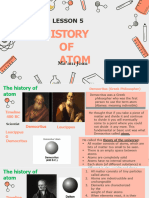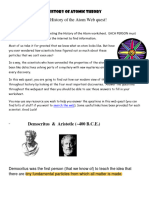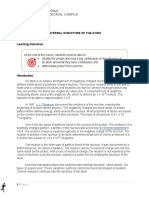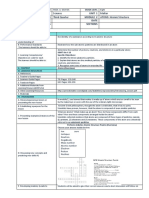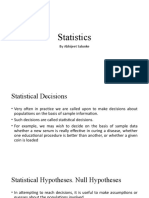November 8, 2022
November 8, 2022
Uploaded by
Melanie CoronaCopyright:
Available Formats
November 8, 2022
November 8, 2022
Uploaded by
Melanie CoronaCopyright
Available Formats
Share this document
Did you find this document useful?
Is this content inappropriate?
Copyright:
Available Formats
November 8, 2022
November 8, 2022
Uploaded by
Melanie CoronaCopyright:
Available Formats
GRADE 1 TO
12
School Claro M. Recto High School Grade Level Grade 9
DAILY LESSON Date November 8, 2022 Learning Area Science
LOG
Day Tuesday 2nd
Quarter
I. OBJECTIVES
A. Content Standards The learners demonstrate an understanding of:
1. the development of atomic models that led to the description of the behavior of electrons
within atoms
2. how atoms combine with other atoms by transferring or sharing electrons
3. forces that hold metals together
II. Performance The learners should be able to:
Standards
Not stated in DBOW
III. Learning The learners should be able to:
Competencies/
Objectives. Write Explain how the Quantum Mechanical Model of the atom describes the energies
the LC code for and positions of the electrons
each.
IV. Objectives
Predict the probable location of electron/s in an atom (include in the discussion the
electron cloud & Heisenberg's Uncertainty Principle).
Illustrate the development of atomic models
V. CONTENT
A. References
1. Teacher’s Guide pages
2. Learner’s Material pages Self-Learning Module
Page 5,12
3. Textbook pages
4. Additional Materials
from Learning Resource
(LR) portal
5. Other Learning
Resources Internet:
http://www.abcte.org/files/previews/chemistry/s1_p6.html#:~:text=Development
https://www.wikilectures.eu/w/Atomic_Models
III.PROCEDURES MATERIALS
A. ELICIT (5 mins) ROUTINARY ACTIVITIES: Attendance
Reviewing previous lesson or Sheet,
presenting the new lesson
Prayer Notebook
Attendance
Reminders
B. ENGAGE (5 mins) ACTIVITY: Projector
Establishing a purpose for the lesson Let’s recall your understanding on the concepts of atom. Identify the word being
Presenting examples/instances of the
described on the following items.
new lesson
Presenting examples of the new
lesson 1. The charge of an atom where the electron is equal to the number of protons.
2. The part of the atom where the mass is concentrated.
3. It is known as the atomic model of Joseph Thomson.
4. The atomic model of Rutherford using gold foil experiment.
5. The negative charge of an atom.
C. EXPLORE (15 mins) DEVELOPMENT OF ATOMIC MODELS Projector
Discussing new concepts and There has been a variety of atomic models throughout history of atomic physics
practicing new skills #1
that refers mainly to a period from the beginning of 19th century to the first half of
20th century, when a final model of atom which is being used nowadays (or
accepted as the most accurate one) was invented. Although the awareness of atom
existence goes way back to the antique period of the world history (Greek
conception of atom), this article will be mainly about five basic atomic models,
from which each one has somehow contributed to how we percept the structure of
atom itself - Dalton´s Billiard Ball Model, J.J Thomson's "plum pudding"
model, Rutherford's Planetary model, Bohr's Atomic model, Electron Cloud
Model/Quantum Mechanics Model.
John Dalton’s atomic model
Ilustration of Dalton's perception of atom
John Dalton was an English scientist, who came up with an idea that all matter is
composed of very small things. It was the first complete attempt to describe all
matter in terms of particles. He called these particles atoms and formed an atomic
theory. In this theory he claims that:
All matter is made of atoms. Atoms are indivisible and indestructible
All atoms of a given element are identical in mass and properties
Compounds are formed by a combination of two or more different kinds
of atoms
A chemical reaction is a rearrangement of atoms
Parts of his theory had to be modified based on the discovery of subatomic
particles and isotopes. We now also know that atoms are not indivisible, because
they are made up of neutrons, electrons and protons.
Plum pudding model
After discovery of an electron in 1897, people realised that atoms are made up of
even smaller particles. Shortly after in 1904 J. J. Thomson proposed his famous
“plum pudding model“. In this model, atoms were known to consist of negatively
charged electrons, however the atomic nucleus had not been discovered yet.
Thomson knew that atom had an overall neutral charge. He thought that there must
be something to counterbalance the negative charge of an electron. He came up
with an idea that negative particles are floating within a soup of diffuse positive
charge. His model is often called the plum pudding model, because of his similarity
to a popular English dessert.
Ilustration of Thomson's perception of atom
Rutherford’s model of the atom
Rutherford was first, who suggested that Thomson’s plum pudding model was
incorrect. His new model introduces nucleus to the atom theory. Nucleus contains
relatively high central charge concentrated into very small volume. This small
volume also contains the bulk of the atomic mass of the atom. Nucleus is
surrounded by lighter and negatively charged electrons. His model is sometimes
known as the planetary model of the atom. However, there were still some major
problems with this model. For example Rutherford could not explain why atoms
only emit light at certain frequencies. This problem was solved later by a Danish
physicist Niels Henrik David Bohr.
Bohr’s model of the atom
Bohr model describes the atom as a positively charged nucleus, which is
surrounded by electrons. Electrons travel in circular orbits, attraction is provided
by electrostatic forces. Normally occupied energy level of the electron is called the
ground state. The electron can move to the less – stable level by absorbing energy.
This higher – energy level is called excited state. The electron can return to its
original level by releasing the energy. All in all, when electron jumps between
orbits, it is accompanied by an emitted or absorbed amount of energy (hv).
Electron Cloud Model/Quantum Mechanics Model of Atom
Quantum Mechanics Model of Atom is nowadays being taught as the most
"realistic" atomic model that describes atomic mechanisms as how present science
presumes they work. It came to exist as a result of combination of number of
scientific assumptions:
1. All particles could be percieved as matter waves with a wavelength.
(Louis de Broglie)
2. Resulting from the previous assumption, atomic model which treats
electrons also as matter waves was proposed. (Erwin Schrödinger,
quantum mechanical atomic model emerged from the solution of
Schrödinger's equation for electron in central electrical field of nucleus.)
3. Principle of uncertainty states that we can't know both the energy and
position of an electron. Therefore, as we learn more about the electron's
position, we know less about its energy, and vice versa. (Werner
Heisenberg)
4. There exists more than one energy level of electron in the atom. Electrons
are assigned certain atomic orbitals that can differ from one another in
energy. (Niels Bohr)
5. Electrons have an intrinsic property called spin, and an electron can have
one of two possible spin values: spin-up or spin-down. Any two electrons
occupying the same orbital must have opposite spins. (the Stern-Gerlach
Experiment)
D. Explain (5 mins) None
Helps students synthesize Recitation:
new knowledge and ask
questions if they need further Based on the Atomic Model presented, where is the location of electrons in an
clarification. atom?
E. Elaborate (10 mins) Recitation: None
Developing mastery (leads to Why do we need to study the previous model of atoms?
formative assessment)
Finding practical applications of
concepts and skills in daily living We are studying the past to better understand the present.
Making generalizations and
abstractions about the lesson
F. EVALUATE (5 mins) Illustrate the following atomic model. Write your answer in a 1 whole sheet of 1 whole sheet
Evaluate learning paper. of paper
Ernest Rutherford (Nuclear Model)
Joseph John Thomson(Plum Pudding Model)
Niels Bohr (Planetary Model)
John Dalton(Solid Sphere Model)
Erwin Schrodinger (Electron Cloud Model)
G. EXTEND (5 mins)
Additional activities for
application of remediation
Have an advance reading about “Electronic Configuration”
Prepared By:
MELANIE L. CORONA
Teacher 1
Checked By:
RONALIZA M. ATIAGAN
Master Teacher 1
Dr. JIBB G. QUIDES
Head Teacher III
Noted By:
RAFFY V. CABALLES
Principal II
You might also like
- Mountain HighDocument26 pagesMountain HighQuercusBooksNo ratings yet
- The History of The Atom Notes - CondensedDocument5 pagesThe History of The Atom Notes - CondensedMarites AguilarNo ratings yet
- Lesson 5, The Structure of AtomDocument3 pagesLesson 5, The Structure of AtomRey OrbeNo ratings yet
- DLL in Science 9Document3 pagesDLL in Science 9Judith Abarquez100% (4)
- Atomic TheoryDocument12 pagesAtomic TheoryGawa GawaNo ratings yet
- Sim Science 7 First QuarterDocument6 pagesSim Science 7 First Quartertriciaarig12No ratings yet
- Science 8 - Modules - Q3 - Sir AljonDocument11 pagesScience 8 - Modules - Q3 - Sir AljonNojla SenoirbNo ratings yet
- Grade11 Physical Science - Module 1Document3 pagesGrade11 Physical Science - Module 1Erickson SongcalNo ratings yet
- Week 1 - LeDocument6 pagesWeek 1 - LeRodney BarbaNo ratings yet
- Lesson 5 History of AtomDocument17 pagesLesson 5 History of AtomTeacher JoanNo ratings yet
- 2nd DLL Physical ScienceDocument4 pages2nd DLL Physical ScienceFilamae JunioNo ratings yet
- What Is Inside The AtomDocument5 pagesWhat Is Inside The AtomSatya KinetaNo ratings yet
- DLP For ObservationDocument7 pagesDLP For ObservationElvie CristobalNo ratings yet
- The History of The Atom Web QuestDocument8 pagesThe History of The Atom Web QuestEthan ElliotNo ratings yet
- Physics Departement Faculty of Math and Science State University Medan 2020Document7 pagesPhysics Departement Faculty of Math and Science State University Medan 2020Aris JuliantoNo ratings yet
- Daily Lesson Plan For Physical ScienceDocument5 pagesDaily Lesson Plan For Physical ScienceWALO100% (1)
- Daily Lesson Plan in Physical Science 12Document5 pagesDaily Lesson Plan in Physical Science 12joyceNo ratings yet
- PhySciLC8 10Document9 pagesPhySciLC8 10John Nerlo DequiñaNo ratings yet
- Physical Science NOV. 13-15, 2019 DLPDocument2 pagesPhysical Science NOV. 13-15, 2019 DLPJedidiah Jara QuidetNo ratings yet
- Week 5 I. ObjectivesDocument6 pagesWeek 5 I. ObjectivesRhissan Bongalosa AcebucheNo ratings yet
- LKPD PPM Nanda Khoirunnisa - 2153023001Document9 pagesLKPD PPM Nanda Khoirunnisa - 21530230011ANanda KhoirunnisaNo ratings yet
- Valeroso, WillaDocument5 pagesValeroso, WillaWILLA ROSE VALEROSONo ratings yet
- Atomic Models NotesDocument4 pagesAtomic Models NotesNube MéndezNo ratings yet
- Panimula: Science 8 3rd April 5-9, 2021Document3 pagesPanimula: Science 8 3rd April 5-9, 2021Michelle Copones LlanesNo ratings yet
- Short NotesDocument16 pagesShort NotesRebuma TadeseNo ratings yet
- Year 8 FT Plan w4Document5 pagesYear 8 FT Plan w4Rikon UchihaNo ratings yet
- 02 01 JournalDocument6 pages02 01 Journalakshay.karthik08No ratings yet
- LP P. Sceie 6Document3 pagesLP P. Sceie 6ADRIEL JAN BRUNONo ratings yet
- Chemistry Modul Theory AtomDocument17 pagesChemistry Modul Theory Atomlevi yunitasariNo ratings yet
- G9 Q2 W1 Atomic ModelsDocument20 pagesG9 Q2 W1 Atomic ModelsCherrilyn Enverzo100% (2)
- Atomic Structure: Defining The AtomDocument2 pagesAtomic Structure: Defining The Atomvincent limNo ratings yet
- Chem M10 What's Inside The AtomDocument30 pagesChem M10 What's Inside The Atommark08311980No ratings yet
- 0893 Intro OTG Week2.3 SOW+Extract+Stage+8-2Document12 pages0893 Intro OTG Week2.3 SOW+Extract+Stage+8-2Zon PhooNo ratings yet
- Year 9 Study Guide ChemistryDocument15 pagesYear 9 Study Guide Chemistryreem halawiNo ratings yet
- Ii. Content Iii. Learning Resources: The Teacher Will Pose Question: 1Document2 pagesIi. Content Iii. Learning Resources: The Teacher Will Pose Question: 1janice alquizarNo ratings yet
- PHY-SCI - ATG - History of The Atomic ModelDocument7 pagesPHY-SCI - ATG - History of The Atomic ModelThrecia PobleteNo ratings yet
- DETAILED LESSON PLAN SubatomicparticlesDocument16 pagesDETAILED LESSON PLAN SubatomicparticlesMary Rose Ramos100% (4)
- DLL-Flame Test 1Document3 pagesDLL-Flame Test 1CYRIL CONSTANTINONo ratings yet
- Q2 Week 1 Copy 1Document5 pagesQ2 Week 1 Copy 1Roberto Misola Jr.No ratings yet
- Sc.G8.Section 1 (Atom and Bonding) .PresentationDocument56 pagesSc.G8.Section 1 (Atom and Bonding) .Presentationomar badraNo ratings yet
- Detailed Lesson Plan in Atomic ModelsDocument14 pagesDetailed Lesson Plan in Atomic ModelsRehina AsutenNo ratings yet
- Structure of Atom PDFDocument82 pagesStructure of Atom PDFAthipatla RahulNo ratings yet
- Atomic Structure HistoryDocument2 pagesAtomic Structure HistoryRogelio Eduardo Gordillo VegaNo ratings yet
- FQ2 T4 TheAtomicStructureOfMatterNETDocument16 pagesFQ2 T4 TheAtomicStructureOfMatterNETrocioruizvaldiviaNo ratings yet
- DLL DemoDocument6 pagesDLL DemoRhissan Bongalosa AcebucheNo ratings yet
- INTERNAL STRUCTURE OF THE ATOM ModuleDocument19 pagesINTERNAL STRUCTURE OF THE ATOM ModuleMary Jane LubricoNo ratings yet
- Teacher Grade Level Learning Area Date & Time: Elements of The Plan I. Preparations AwarenessDocument3 pagesTeacher Grade Level Learning Area Date & Time: Elements of The Plan I. Preparations AwarenessRicah AstonNo ratings yet
- Subatomic ParticlesDocument3 pagesSubatomic Particlesjovelo.delapenaNo ratings yet
- DEGUZMAN KS3 LeaP G8Q3W6Document3 pagesDEGUZMAN KS3 LeaP G8Q3W6Michelle Copones LlanesNo ratings yet
- Learning Area UNIT 1 Matter QUARTER Third Quarter MODULE 2 ATOMS: Atomic Structure Date Date Sections SectionsDocument37 pagesLearning Area UNIT 1 Matter QUARTER Third Quarter MODULE 2 ATOMS: Atomic Structure Date Date Sections SectionsAdrian Suladay100% (1)
- Physical Science NOV. 11-12, 2019 DLPDocument2 pagesPhysical Science NOV. 11-12, 2019 DLPJedidiah Jara QuidetNo ratings yet
- Phy Sci Week 4Document8 pagesPhy Sci Week 4Queency Panaglima PadidaNo ratings yet
- Science DLLDocument5 pagesScience DLLzeck100% (1)
- CH 7 Lesson 1 DennyDocument6 pagesCH 7 Lesson 1 Dennyapi-254594631No ratings yet
- JAN 22-26 PrelimDocument10 pagesJAN 22-26 PrelimMa. Theresa CatayocNo ratings yet
- Grade 9 Unit 1Document34 pagesGrade 9 Unit 1Daniel AlemuNo ratings yet
- S8Mt Iiiee F 10Document2 pagesS8Mt Iiiee F 10LENETTE ALAGONNo ratings yet
- DLL chemNOV13Document3 pagesDLL chemNOV13Rosallie Caaya-NuezNo ratings yet
- Grade 11 Pythagoras Pointers For Physical ScienceDocument5 pagesGrade 11 Pythagoras Pointers For Physical ScienceSuzette Ann MantillaNo ratings yet
- DLL Science 8 Fourth WeekDocument3 pagesDLL Science 8 Fourth WeekIamsuperrichell ReyNo ratings yet
- November 10, 2022Document3 pagesNovember 10, 2022Melanie CoronaNo ratings yet
- November 7, 2022Document2 pagesNovember 7, 2022Melanie CoronaNo ratings yet
- May 3, 2023Document4 pagesMay 3, 2023Melanie CoronaNo ratings yet
- May 10, 2023Document7 pagesMay 10, 2023Melanie CoronaNo ratings yet
- November 11, 2022Document2 pagesNovember 11, 2022Melanie CoronaNo ratings yet
- May 5, 2023Document3 pagesMay 5, 2023Melanie CoronaNo ratings yet
- May 2, 2023Document3 pagesMay 2, 2023Melanie CoronaNo ratings yet
- November 3, 2022Document3 pagesNovember 3, 2022Melanie CoronaNo ratings yet
- September 2, 2022Document3 pagesSeptember 2, 2022Melanie CoronaNo ratings yet
- March 1, 2023 - CODocument5 pagesMarch 1, 2023 - COMelanie CoronaNo ratings yet
- Impulse and Momentum Lesson PlanDocument5 pagesImpulse and Momentum Lesson PlanMelanie CoronaNo ratings yet
- Science Time!: With Ma'am Melanie!Document19 pagesScience Time!: With Ma'am Melanie!Melanie CoronaNo ratings yet
- Science Time: With Ma'Am Melanie!Document81 pagesScience Time: With Ma'Am Melanie!Melanie CoronaNo ratings yet
- August 26, 2022Document4 pagesAugust 26, 2022Melanie CoronaNo ratings yet
- Science 9: Miss Melanie L. CoronaDocument27 pagesScience 9: Miss Melanie L. CoronaMelanie CoronaNo ratings yet
- Structure and Function: Circulatory System: Journey Into A Man's HeartDocument43 pagesStructure and Function: Circulatory System: Journey Into A Man's HeartMelanie CoronaNo ratings yet
- Science Time: With Ma'am Melanie!Document38 pagesScience Time: With Ma'am Melanie!Melanie CoronaNo ratings yet
- Table of Specification: Wellspring Academy of Canlubang, IncDocument1 pageTable of Specification: Wellspring Academy of Canlubang, IncMelanie CoronaNo ratings yet
- TVL Bread & Pastry Production-Q1-M5Document15 pagesTVL Bread & Pastry Production-Q1-M5John Paul AnapiNo ratings yet
- Audiovisual TouringBrochure SLAMLexDocument44 pagesAudiovisual TouringBrochure SLAMLexantonioNo ratings yet
- (A People's History of India 2) Irfan Habib - The Indus Civilization-Tulika Books (2002)Document128 pages(A People's History of India 2) Irfan Habib - The Indus Civilization-Tulika Books (2002)srabani chakrabortyNo ratings yet
- Material Master Purchase Order TextDocument6 pagesMaterial Master Purchase Order Textapi-12352301No ratings yet
- Statistics 1Document34 pagesStatistics 1Abhishek GuptaNo ratings yet
- Resume - Sasi KumarDocument5 pagesResume - Sasi KumarLovely BirdNo ratings yet
- Aits 1718 CRT Iv Jeea Paper 1 Sol PDFDocument9 pagesAits 1718 CRT Iv Jeea Paper 1 Sol PDFsamarth goswamiNo ratings yet
- Wolverine Reading OrderDocument2 pagesWolverine Reading OrderTomasHamNo ratings yet
- Waiting For Godot Short QsDocument4 pagesWaiting For Godot Short QsNoor Ul Ain33% (3)
- Waves and em Spectrum Work SheetDocument2 pagesWaves and em Spectrum Work SheetSenpai ChibiNo ratings yet
- NT20S Programmable Terminal: Operation ManualDocument308 pagesNT20S Programmable Terminal: Operation Manualelahmady.1409No ratings yet
- Public Policy: From Legal Issues To Privacy: Name Mohd Saif Ansari SEC 'B' ROLL NO 0204741Document52 pagesPublic Policy: From Legal Issues To Privacy: Name Mohd Saif Ansari SEC 'B' ROLL NO 0204741741Mohd Saif AnsariNo ratings yet
- NSE Ikeja January 2017 News LetterDocument7 pagesNSE Ikeja January 2017 News LetterbbllngNo ratings yet
- The Everyday Healthy Vegetarian by Nandita IyerDocument458 pagesThe Everyday Healthy Vegetarian by Nandita Iyervickyrwt0404No ratings yet
- FASTADocument4 pagesFASTADhakshayani GNo ratings yet
- To Kill A Mockingbird - Example of Escape andDocument6 pagesTo Kill A Mockingbird - Example of Escape andCatherine Nicole SamsonNo ratings yet
- LogDocument26 pagesLogmarselameiNo ratings yet
- Factors Influencing On Grade 12 Students Chosen Courses in Jagobiao National High School - Senior High School DepartmentDocument12 pagesFactors Influencing On Grade 12 Students Chosen Courses in Jagobiao National High School - Senior High School DepartmentBianca Marie Uypala ErquilangNo ratings yet
- Climate Warrior PlanDocument2 pagesClimate Warrior Planhrishikesh.ghatnekarNo ratings yet
- Department of The Army Technical BulletinDocument44 pagesDepartment of The Army Technical BulletinglcainesNo ratings yet
- How Do You Figure - Matt MccabeDocument5 pagesHow Do You Figure - Matt Mccabeapi-297833297No ratings yet
- Merelani Hills, Lelatema Mountains, Simanjiro District, Manyara Region, TanzaniaDocument1 pageMerelani Hills, Lelatema Mountains, Simanjiro District, Manyara Region, TanzaniaJunsaku YoshiharaNo ratings yet
- B.Pharmacy-4 Semester (New PCI Syllabus) : Drug Acting On Central Nervous SystemDocument4 pagesB.Pharmacy-4 Semester (New PCI Syllabus) : Drug Acting On Central Nervous SystemAli Veer Ali VeerNo ratings yet
- DcTrack InstallationDocument4 pagesDcTrack InstallationcbertiniNo ratings yet
- Crouse Hinds MTL Barracuda WorkstationsDocument4 pagesCrouse Hinds MTL Barracuda Workstationszhang012mike0727No ratings yet
- Deepak Gupta ResumeDocument4 pagesDeepak Gupta Resumedev sharmaNo ratings yet
- MBTI Conflict Style TypesDocument11 pagesMBTI Conflict Style TypesfbxurumelaNo ratings yet
- At L La Grade 8 Past PerfectDocument4 pagesAt L La Grade 8 Past PerfectJoseane de Lima MartinsNo ratings yet
- Antibiotics After Shoulder Joint Replacement by TENDAI MUTSOPOTSIDocument2 pagesAntibiotics After Shoulder Joint Replacement by TENDAI MUTSOPOTSIPhysiotherapy Care SpecialistsNo ratings yet









